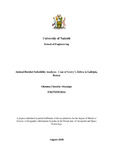Animal habitat suitability analysis: case of grevy’s zebra in Laikipia, Kenya

View/
Date
2018-08Author
Otuoma, Timothy O
Type
ThesisLanguage
enMetadata
Show full item recordAbstract
Habitat suitability maps have been used to provide information for environment resource planning and management. There are many causes of environmental degradation, natural and man-made. Wildlife has been especially affected by human interference. For instance, Grevy’s zebras have become endangered. A number of efforts have been put forward by experts to understand the factors affecting their existence. There has been a number of conservation efforts put in place to manage the natural habitats for Grevy’s Zebras. The Kenya government has not only banned the hunting of Grevy’s zebras, but has also revised the conservation status of Grevy’s zebras from ‘Game animal’ to ‘Protected animal’. This study aimed at identifying and exploring habitat suitability for Grevy’s zebra in Laikipia, Kenya using GIS. Vegetation cover, slope, proximity to water point, settlement and road were identified as the major Grevy’s zebra habitat defining factors. Hence, their influences were analysed and reclassified for evaluating the suitable habitat. Implementing Geographic Information System (GIS) methods and tools such as weighted overlay and Analytical Hierarchy Process (AHP) would give a better understanding of the dynamics in nature and thereby allow better prediction and planning. The relative importance of the factors was determined through key informant interview and their weights were determined through AHP. The final suitable habitat map showed that suitable sites in Laikipia are not continuous and are in very close proximity to human settlements and human activities. Integrating this study into habitat conservation planning and management practices, would enhance decision making. More factors such as predation should be assessed with respect to their effect on Grevy’s zebra habitat choice.
